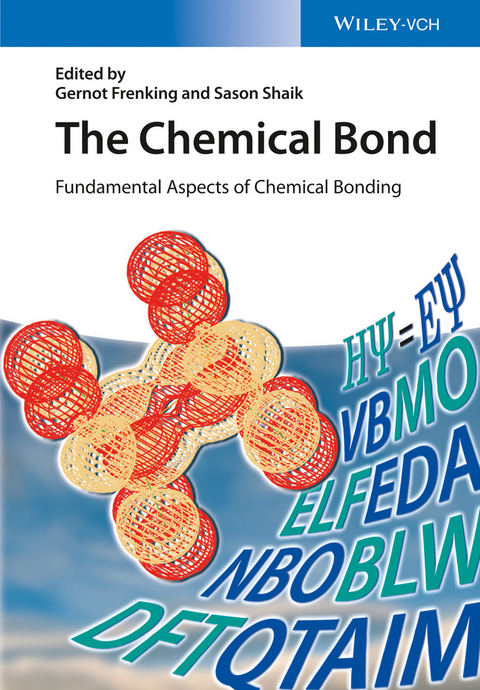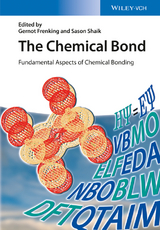The Chemical Bond
Wiley-VCH (Verlag)
978-3-527-33314-1 (ISBN)
This is the perfect complement to "Chemical Bonding - Across the Periodic Table" by the same editors, who are two of the top scientists working on this topic, each with extensive experience and important connections within the community.The resulting book is a unique overview of the different approaches used for describing a chemical bond, including molecular-orbital based, valence-bond based, ELF, AIM and density-functional based methods. It takes into account the many developments that have taken place in the field over the past few decades due to the rapid advances in quantum chemical models and faster computers.
Gernot Frenking studied chemistry at the Technical University Aachen (Germany). He then became a research atudent in the group of Prof. Kenichi Fukui in Kyoto (Japan) and completed his PhD and his habilitation at Technical University Berlin (Germany). He was then a visiting scientist at the University of California, Berkeley (USA) and a staff scientist at SRI International in Menlo Park, California (USA). Since 1990 he is Professor for Computational Chemistry at the Philipps-Universität Marburg. Sason Shaik is a graduate of the University of Washington (USA), where he also obtained his PhD. After a postdoctoral year at Cornell University, he became Lecturer at Ben-Gurion University of the Negev (Israel), where he became Professor in 1988. In 1992 he moved to The Hebrew University where he is Professor and the Director of the Lise Meitner-Minerva Center for Computational Quantum Chemistry.
Preface
THE PYHSICAL ORIGIN OF COVALENT BONDING
The Quest for a Physical Model of Covalent Bonding
Rigorous Basis for Conceptual Reasoning
Atoms in Molecules
The One-Electron Basis of Covalent Binding: H2+
The Effect of Electronic Interaction in the Covalent Electron Pair Bond: H2
Covalent Bonding in Molecules with More than Two Electrons: B2, C2, N2, O2, and F2
Conclusions
BRIDGING CULTURES
Introduction
A Short History of the MO/VB Rivalry
Mapping MO-Based Wave Functions to VB Wave Functions
Localized Bond Orbitals - A Pictorial Bridge between MO and VB Wave Functions
Block-Localized Wave Function Method
Generalized Valence Bond Theory: a Simple Bridge from VB to MOs
VB Reading of CASSCF Wave Functions
Natural Bonding Orbitals and Natural Resonance Theory - a Direct Bridge between MO and VB
The Mythical Conflict of Hybrid Orbitals with Photoelectron Spectroscopy
Conclusion
Appendix
THE NBO VIEW OF CHEMICAL BONDING
Introduction
Natural Bond Orbital Methods
Beyond Lewis-Like Bonding: The Donor-Acceptor Paradigm
Conclusion
THE EDA PERSPECTIVE OF CHEMICAL BONDING
Introduction
Basic Principles of the EDA Method
The EDA-NOCV Method
Chemical Bonding in H2 and N2
Comparison of Bonding in Isoelectronic N2, CO and BF
Bonding in the Diatomic Molecules E2 of the First Octal Row E=Li-F
Bonding in the Dihalogens F2 - I2
Carbon-Element Bonding in CH3-X
EDA-NOCV Analysis of Chemical Bonding in the Transition State
Summary and Conclusion
THE VALENCE BOND PERSPECTIVE OF THE CHEMICAL BOND
Introduction
A Brief Historical Recounting of the Development of the Chemical Bond Notion
The Pauling-Lewis VB Perspective of the Electron-Pair Bond
A Preamble to the Modern VB Perspective of the Electron-Pair Bond
Theoretical Characterization of Bond Types by VB and Other Methods
Trends of Bond Types Revealed by VB, AIM and ELF
Physical Origins of CS Bonding
Global Behavior of Electron-Pair Bonds
Additional Factors of CS Bonding
Can a Covalent Bond Become CS Bonds by Substitution?
Experimental Manifestations of CS Bonding
Scope and Territory of CS Bonding
Appendix
THE BLOCK-LOCALIZED WAVEFUNCTION (BLW) PERSPECTIVE OF CHEMICAL BONDING
Introduction
Methodology Evolutions
Exemplary Applications
Conclusion
Outlook
THE CONCEPTUAL DENSITY FUNCTIONAL THEORY PERSPECTIVE OF BONDING
Introduction
Basics of DFT: The Density as a Fundamental Carrier of Information and How to Obtain It
Conceptual DFT: A Perturbative Approach to Chemical Reactivity and the Process of Bond Formation
Conclusions
THE QTAIM PERSPECTIVE OF CHEMICAL BONDING
Introduction
Birth of QTAIM: the Quantum Atom
The Topological Atom: is it also a Quantum Atom?
The Bond Critical Point and the Bond Path
Energy Partitioning Revisited
Conclusion
THE EXPERIMENTAL DENSITY PERSPECTIVE OF CHEMICAL BONDING
Introduction
Asphericity Shifts and the Breakdown of the Standard X-ray Model
Precision of Charge Density Distributions in Experimental and Theoretical Studies
Core Density Deformations Induced by Chemical Bonding
How Strongly Is the Static Electron Density Distribution Biased by Thermal Motion?
Relativistic Effects on the Topology of Electron Density
The Topology of the Laplacian and the MO Picture - Two Sides of the Same Coin?
Elusive Charge Density Phenomena: Nonnuclear Attractors
THE ELF PERSPECTIVE OF CHEMICAL BONDING
Introduction
Definitions
Simple examples
Solids
Perspectives
Appendix
RELATIVITY AND CHEMICAL BONDING
Introduction
Direct and Indirect Relativistic Effects and Spin-Orbit Coupling
Chemical Bonding and Relativistic Effects
Conclusions
Index
"The two volumes would serve upper-level undergraduates who are well versed in mathematics and chemistry, but they are most suitable for graduate students, faculty, and researchers in chemistry. The exhaustive chapter references make each book a useful go-to reference source. Highly recommended. Upper-division undergraduates, graduate students, and researchers/faculty." ( Choice , 1 May 2015)
| Erscheint lt. Verlag | 21.5.2014 |
|---|---|
| Reihe/Serie | The Chemical Bond |
| Verlagsort | Weinheim |
| Sprache | englisch |
| Maße | 170 x 244 mm |
| Gewicht | 973 g |
| Themenwelt | Naturwissenschaften ► Chemie ► Physikalische Chemie |
| Schlagworte | Anorganische Chemie • Bindung (Chemie) • Chemie • Chemische Bindung • Chemistry • Computational Chemistry & Molecular Modeling • Computational Chemistry & Molecular Modeling • Computational Chemistry u. Molecular Modeling • Inorganic Chemistry • Organic Chemistry • Organische Chemie • Physical Chemistry • Physikalische Chemie |
| ISBN-10 | 3-527-33314-2 / 3527333142 |
| ISBN-13 | 978-3-527-33314-1 / 9783527333141 |
| Zustand | Neuware |
| Informationen gemäß Produktsicherheitsverordnung (GPSR) | |
| Haben Sie eine Frage zum Produkt? |
aus dem Bereich




